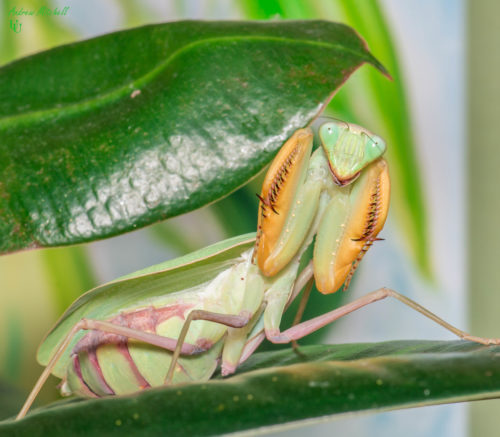Description
African Lined Mantis Sphodromantis lineola
African Lined Mantis (Sphodromantis lineola) is endemic to Central and Western sub-Saharan Africa living in forest and savanna thickets. Their natural diet usually consists of locusts, grasshoppers and other invertebrates.
It is a medium/large species which can grow up to 8cm in length. They have large, long abdomens and like all mantids, thin, stem-like legs. The front pair of legs have a serrated edge to allow the mantis to catch and grip its large prey items. Their colour varies mantis to mantis, but is usually a shade of brown or green, which can be determined by environmental factors such as humidity. After the final moult, the adults will be capable of flight, which will show off their beautiful wings. These have small dots to resemble eyes (similar to butterflies) which confuses potential predators.
ref: Wikipedia re African Lined Mantis – Sphodromantis lineola
Sphodromantis lineola, common name African mantis or African praying mantis, is a species of praying mantis from Africa sometimes raised in captivity. S. lineola is often colored green, however they can also be colored different types of brown. The brown colored individuals have also been observed with purple colored eyes. It may be distinguished from S. baccettii by the absence of blue-black spots on its forearms.
The visual system of the S. lineola is the most studied aspect of this species. In fact, this species is the most studied in this topic. Since S. lineola are sit and wait predators they have a well developed motion detection visual system. This species of mantis like most other species have apposition based compound eyes and mantises are the only invertebrates known to use stereoscopic vision. They use looming signals in order to detect and calculate other organisms or objects heading towards them using motion-in-depth perception. Using this system they are able to calculate based on speed whether to resort to predatory or defensive strikes. They also have also demonstrated to respond to visual cues which are not of their usual prey or that they have ever encountered which complements their larger range of prey due to scarcity in nature. However some studies do denote that there is no evidence of this species being able to judge the size of their prey and mostly just focus on their depth, which can probably be connected to their generalist predatory behavior.
Much Like the rest of the mantids they are mainly insectivores preying on other insects. However, Mantids are also known to be able to capture and feed on vertebrates. These ferocious predators are not picky predators and are very opportunistic. This is due to the fact that in nature prey is scarce and are often in a state of hunger. Hence, why female mantids including this species will resort to post mating cannibalism to supplement the energy and nutrition needed to survive and reproduce. Like most praying mantis this species is an ambush predator. They use their well developed motion detection visual systems as well as proprioceptive information to detect prey and then deliver a carefully calculated and extremely accurate strike.
Males are mainly attracted to females through olfactory and visual signals as well as with tactile cues. Studies have shown that hormones alone are not responsible for attraction of males by females. Females must perform mainly specific antennal movements as a premating behavior along with hormones in order to attract the attention of the males.
Many mantid species are known to show cannibalism post copulation, S. lineola being one of this species. Studies have come to the conclusion that this behavior can be attributed female mantids needing nutrition in order to produce more offspring. It has been documented that females of this species are commonly in a state of hunger in natural settings which is shown to be a driver of this behavior. In captivity, under circumstances in which females are well fed, they have shown to not perform cannibalism on the male mantid after copulation. Other ways for males to avoid being eaten by their mate is through different courtship behaviors such as sneaking on the female or swiftly jumping on their back whilst trying to avoid being eaten. Although under most natural circumstances these are often ineffective.





